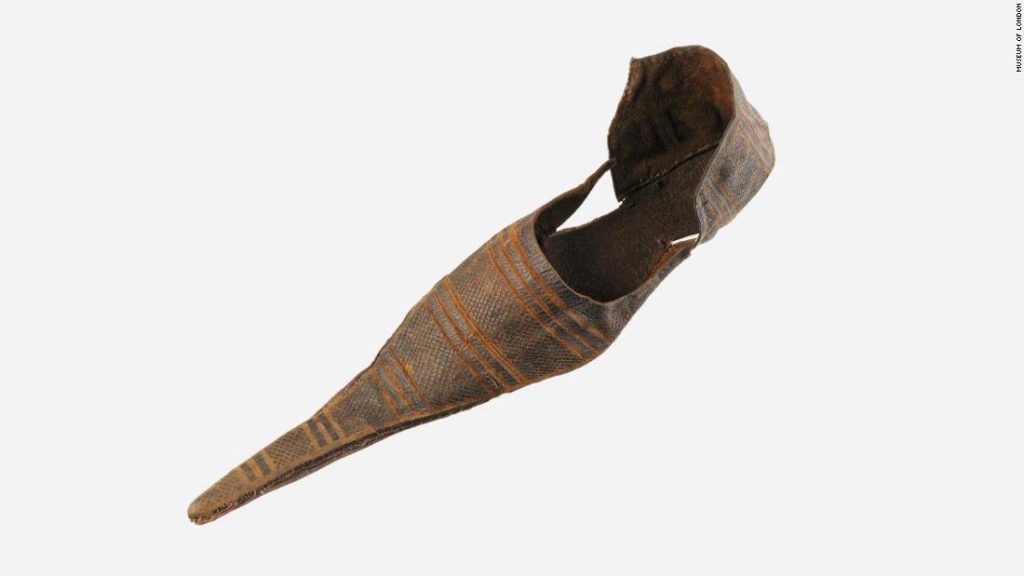They were the Jimmy Choos of their day.
Known as poulaines, pointy leather shoes were the height of fashion in 14th century Britain. Medieval men and women about town, however, suffered for their fancy footwear: They got bunions.
“You get degenerative changes in the bones of the feet. There’s very clear osteological signs that the toes were pushed laterally. And there’s basically holes in the bone suggesting that the ligaments were pulling away. It looks painful to look at the bone,” said Dittmar, a research fellow at the University of Aberdeen, who was at the University of Cambridge while she conducted the research.
A bunion forms when the big toe becomes angled and a bony protrusion forms on the inside of the foot. The deformity is often associated with high heels and constrictive footwear, although other factors like genetics play a role. The bump can be painful and make it harder to balance.

Excavated medieval foot bones show a bunion, with lateral deviation of the big toe. Credit: Jenna Dittmar
Intrigued by the unexpected prevalence of bunions, Dittmar and her colleagues analyzed a total of 177 skeletons from the 11th to the 15th centuries buried in and around Cambridge in the United Kingdom. The research team found that 27% of the skeletons dating from the 14th and 15th centuries suffered from bunions, compared with only 6% that dated back between the 11th and 13th centuries.
The 1300s saw the arrival of new styles of dress and footwear in a wider range of fabrics and colors, the researchers said, and the remains of shoes excavated in London and Cambridge by the late 14th century suggest that almost every type of shoe — for adults and children — was at least slightly pointed.

This pointed-toe medieval shoe is known as a poulaine. The artifact dates from the late 14th century and is on display at the Museum of London. Credit: Museum of London
It was unclear whether the shoes had heels, Dittmar said. Materials like wood that the heels could have been made from do not preserve well in the archaeological record.
Fashionista friars
Wealthier, higher-status individuals living in urban areas were more likely to have suffered from bunions, the study of the skeletons, which came from four different cemeteries around Cambridge, suggested.
Only 3% of the skeletons in the rural cemetery 3.7 miles (6 kilometers) south of the city and 10% of the parish graveyard in the outskirts of the town, where many working poor were buried, showed signs of bunions.
In comparison, evidence of bunions was found on 23% of those buried on the site of a charitable hospital that is now part of St. John’s College and 43% of those interred in the grounds of a former Augustinian friary — mainly clergy and wealthy benefactors.

Members of the Cambridge Archaeological Unit at work on the excavation of skeletons in 2010. Credit: Cambridge Archaeological Unit
While friars were supposed to wear clothes that reflected a simple lifestyle of worship, it was common for clergy to wear stylish attire. Fly clergy were such a concern to church officials that they were forbidden from wearing pointed-toe shoes in 1215. That said, the decree appeared to have little effect, with further edicts on clerical dress passed in 1281 and 1342, the study noted.
More male skeletons in the study had bunions than female ones, but Dittmar said that the study sample had fewer female skeletons and the team couldn’t conclude that there was a gender divide.
The study also found the skeletons of those who died over the age 45 with Hallux valgus were also more likely to show signs of fractures that usually result from a fall. For example, fractures to upper limbs could indicate an individual tumbled forward onto outstretched arms.
“Modern clinical research on patients with Hallux valgus has shown that the deformity makes it harder to balance, and increases the risk of falls in older people,” Dittmar said. “This would explain the higher number of healed broken bones we found in medieval skeletons with this condition.”
The study was published in the International Journal of Paleopathology.
You may also like
-
Afghanistan: Civilian casualties hit record high amid US withdrawal, UN says
-
How Taiwan is trying to defend against a cyber ‘World War III’
-
Pandemic travel news this week: Quarantine escapes and airplane disguises
-
Why would anyone trust Brexit Britain again?
-
Black fungus: A second crisis is killing survivors of India’s worst Covid wave

